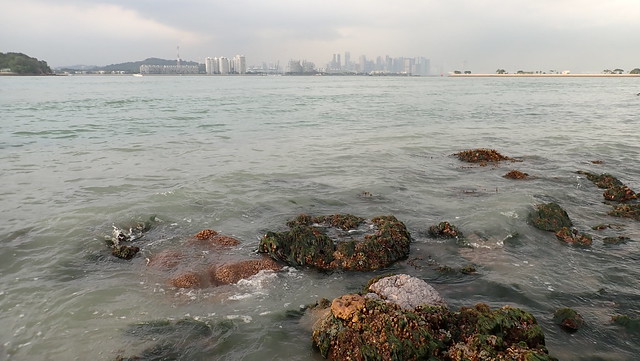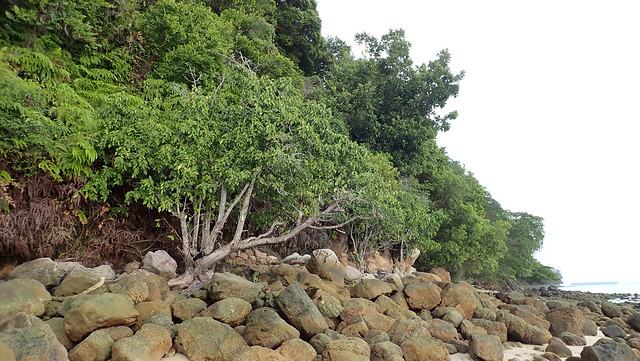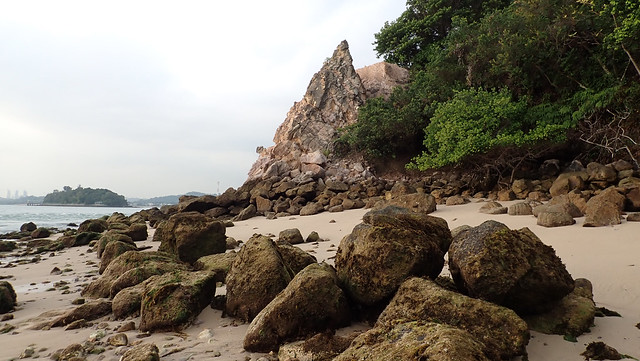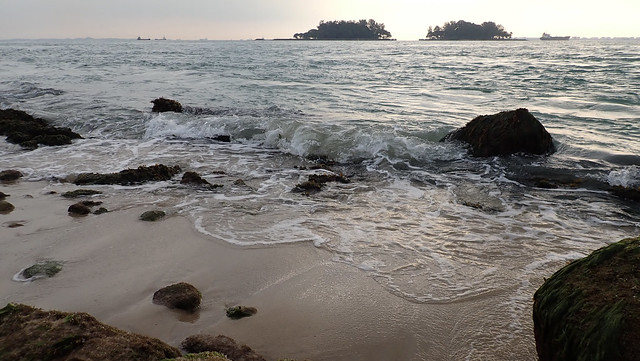A short boat ride from the Central Business District on the main island of Singapore, are the amazing living shores of St John's Island!
The shores seem livelier than our last survey in Mar 2019! Corals, seagrasses and marine critters are doing better! The grandmother Nyireh laut tree is still alive and the beautiful coastal forest there looks fine. We also avoided stepping on a stonefish and death by lightning.
Although most of St John's eastern shoreline has been reclaimed or have artificial seawalls, the northern tip remains untouched. Here's a brief clip of the views on this lovely natural shore.
There have always not been many corals on this shore. But today, I came across a good variety of common corals and most were in good health.
The most abundant were large Pore corals, and many small colonies of Anemone corals with scattered colonies of Merulinid corals of various kinds. I sense this is much better than what we saw on our last survey in Mar 2019.
I also saw many small to medium sized Leathery soft corals of various kinds. I saw a small Leathery sea fan, while the rest of the team saw a much bigger one.
Today, I saw many more Magnificent anemones on this shore than I have before in the past. I also saw Giant carpet anemones, Frilly anemones and in the sandy lagoons, Haddon's carpet anemones with shrimps.
I also saw a variety of sponges and other common cnidarians like corallimorphs and zoanthids.
In the sandy lagoon, Kok Sheng spotted the Forskal's sidegill slug in the ascidian-infested seagrass patches. I also saw a few large Cake sand dollars and some Common sea stars. Jianlin found a small green Knobbly sea star and Kok Sheng found a Tiny seven-armed sea star. The rest of the team also saw many more nudibranchs and slugs of various kinds.
I made the pilgrimage past the tip of the northern shore. To pay my respects to the grandmother Nyireh laut tree. She is still very much alive! The last time I saw her was in Dec 2016.
The two daughter trees next to grandma are still alright. But one dead tree nearby looks like a Nyireh laut that didn't survive what looks like a tree fall from the cliffside.
I love this shore mainly for the beautiful natural coastal forest that still grows here. There are not too many of these left in Singapore.
Some interesting plants seen in this beautiful coastal forest include: Chengam and Seashore pandan - both flowering, and a garland of what looks like Raffles pitcher plant.
There are also some stunning natural rock formations here.
This western shore of St John's Island is part of the Sisters Islands Marine Park!
It was great to see many small clumps of Tape seagrass, most with fresh green and moderately long leaf blades. There were also sprinkles of Spoons seagrass (with small leaves) all over the shores.
A bloom of golden Sargassum seaweed is normal for this time of the year. I noticed, there was also a bloom of Beehoon green seaweed (Chaetomorpha). This made it hard to safely survey the reef edge.
Everywhere on the mid-shore, there was also a bloom of Hairy green seaweed (Bryopsis).
Vincent spotted a Hollow-cheeked stonefish! Which Kok Sheng and I totally missed walking past the same route.
The wet weather missed us until after sunset, when the lightning hit pretty close to shore. Fortunately, by that time, we were already safely under shelter. It was a relief not to see any fish traps on the shore. I hope this shore continues to do well until our next survey.
St John's Island in the Singapore Blue Plan
The Singapore Blue Plan 2018 highlights the importance of St John's Island to our marine biodiversity.
The cluster of Kusu, Lazarus and St. John's Islands has been recommended by the Singapore Blue Plan 2018 for elevated protection status. The Blue Plan highlights that Lazarus, St. John’s, and Kusu Islands are established sites for coral nurseries as their shoreline offers ideal sheltered areas for growth of corals. Designating these islands as No-fishing Areas can bolster their rehabilitation.
Protecting a larger cluster of islands means zonation plans for use can be implemented to manage tourism and human impacts.
DOWNLOAD the Plan, SUPPORT the Plan! More on the Singapore Blue Plan 2018 site.
Photos by others on this trip
Loh Kok Sheng
Jianlin Liu
Marcus Ng
Liz Lim
Vincent Choo
Kelvin Yong
Joleen Chan
Victor Toh

















